Energy of a Vibrating Mass on a Spring - Questions
The Energy of a Vibrating Mass on a Spring Concept Builder is comprised of 70 questions. The questions are divided into 24 different Question Groups. Questions in the same group are rather similar to one another. The Concept Builder is coded to select at random a question from each group until a student is successful with that group of questions.
There are four different activities that can be engaged in through the Concept Builder. Those four activities are differentiated as follows:
- KE, PE, and TME: Question Groups 1 - 6 ... Describe how the KE, PE, and TME changes as a mass vibrates on a horizontal or a vertical spring.
- Energy Bar Charts: Question Groups 7-12 ... Identify the correct energy bar charts for a mass vibrating on a horizontal spring.
- Do It With Numbers 1: Question Groups 13-18 ... Given the KE and PE values at one location for a mass vibrating on a horizontal spring, identify the KE and PE values at a second location.
- Do It With Numbers 2: Question Groups 19-24 ... Given the KE and PE values at one location for a mass vibrating on a vertical spring, identify the KE and PE values at a second location.
The questions from each group are shown below. Teachers are encouraged to view the questions in order to judge which activities are most appropriate for their classes. We recommend providing students two or more options.
The Physics Classroom grants teachers and other users the right to print these questions for private use. Users are also granted the right to copy the text and modify it for their own use. However, this document should not be uploaded to other servers for distribution to and/or display by others. The Physics Classroom website should remain the only website or server from which the document is distributed or displayed. We also provide a PDF that teachers can use under the same conditions. We have included a link to the PDF near the bottom of this page.
Energy of a Vibrating Mass on a Spring
Activity 1 KE, PE, and TME
Question Group 1
 Question 1
Question 1
A spring is attached to a ceiling hook. A mass is attached to the spring and pulled down to position A. It is released from rest and vibrates back and forth between positions A and C. Position B is the equilibrium position. Assuming no damping, what changes would be observed as the mass vibrates from locations
A to B?
The
kinetic energy would …
a. increase b. decrease c. first increase and then decrease
d. first decrease and then increase e. remain unchanged
The
gravitational potential energy would …
a. increase b. decrease c. first increase and then decrease
d. first decrease and then increase e. remain unchanged
The
elastic potential energy would …
a. increase b. decrease c. first increase and then decrease
d. first decrease and then increase e. remain unchanged
The
total mechanical energy would …
a. increase b. decrease c. first increase and then decrease
d. first decrease and then increase e. remain unchanged
 Question 2
Question 2
A spring is attached to a ceiling hook. A mass is attached to the spring and pulled down to position A. It is released from rest and vibrates back and forth between positions A and C. Position B is the equilibrium position. Assuming no damping, what changes would be observed as the mass vibrates from locations
A to B?
The
kinetic energy would …
a. remain unchanged b. increase
c. first increase and then decrease
d. decrease e. first decrease and then increase
The
gravitational potential energy would …
a. remain unchanged b. increase
c. first increase and then decrease
d. decrease e. first decrease and then increase
The
elastic potential energy would …
a. remain unchanged b. increase
c. first increase and then decrease
d. decrease e. first decrease and then increase
The
total mechanical energy would …
a. remain unchanged b. increase
c. first increase and then decrease
d. decrease e. first decrease and then increase
 Question Group 2
Question 3
Question Group 2
Question 3
A spring is attached to a ceiling hook. A mass is attached to the spring and pulled down to position A. It is released from rest and vibrates back and forth between positions A and C. Position B is the equilibrium position. Assuming no damping, what changes would be observed as the mass vibrates from locations
C to B?
The
kinetic energy would …
a. increase b. decrease c. first increase and then decrease
d. first decrease and then increase e. remain unchanged
The
gravitational potential energy would …
a. increase b. decrease c. first increase and then decrease
d. first decrease and then increase e. remain unchanged
The
elastic potential energy would …
a. increase b. decrease c. first increase and then decrease
d. first decrease and then increase e. remain unchanged
The
total mechanical energy would …
a. increase b. decrease c. first increase and then decrease
d. first decrease and then increase e. remain unchanged
Question 4

A spring is attached to a ceiling hook. A mass is attached to the spring and pulled down to position A. It is released from rest and vibrates back and forth between positions A and C. Position B is the equilibrium position. Assuming no damping, what changes would be observed as the mass vibrates from locations
C to B?
The
kinetic energy would …
a. remain unchanged b. increase
c. first increase and then decrease
d. decrease e. first decrease and then increase
The
gravitational potential energy would …
a. remain unchanged b. increase
c. first increase and then decrease
d. decrease e. first decrease and then increase
The
elastic potential energy would …
a. remain unchanged b. increase
c. first increase and then decrease
d. decrease e. first decrease and then increase
The
total mechanical energy would …
a. remain unchanged b. increase
c. first increase and then decrease
d. decrease e. first decrease and then increase
Question Group 3
 Question 5
Question 5
A spring is attached to a ceiling hook. A mass is attached to the spring and pulled down to position A. It is released from rest and vibrates back and forth between positions A and C. Position B is the equilibrium position. Assuming no damping, what changes would be observed as the mass vibrates from locations
B to A?
The
kinetic energy would …
a. increase b. decrease c. first increase and then decrease
d. first decrease and then increase e. remain unchanged
The
gravitational potential energy would …
a. increase b. decrease c. first increase and then decrease
d. first decrease and then increase e. remain unchanged
The
elastic potential energy would …
a. increase b. decrease c. first increase and then decrease
d. first decrease and then increase e. remain unchanged
The
total mechanical energy would …
a. increase b. decrease c. first increase and then decrease
d. first decrease and then increase e. remain unchanged
 Question 6
Question 6
A spring is attached to a ceiling hook. A mass is attached to the spring and pulled down to position A. It is released from rest and vibrates back and forth between positions A and C. Position B is the equilibrium position. Assuming no damping, what changes would be observed as the mass vibrates from locations
B to A?
The
kinetic energy would …
a. remain unchanged b. increase
c. first increase and then decrease
d. decrease e. first decrease and then increase
The
gravitational potential energy would …
a. remain unchanged b. increase
c. first increase and then decrease
d. decrease e. first decrease and then increase
The
elastic potential energy would …
a. remain unchanged b. increase
c. first increase and then decrease
d. decrease e. first decrease and then increase
The
total mechanical energy would …
a. remain unchanged b. increase
c. first increase and then decrease
d. decrease e. first decrease and then increase
Question Group 4
Question 7

A spring is attached to a ceiling hook. A mass is attached to the spring and pulled down to position A. It is released from rest and vibrates back and forth between positions A and C. Position B is the equilibrium position. Assuming no damping, what changes would be observed as the mass vibrates from locations
B to C?
The
kinetic energy would …
a. increase b. decrease c. first increase and then decrease
d. first decrease and then increase e. remain unchanged
The
gravitational potential energy would …
a. increase b. decrease c. first increase and then decrease
d. first decrease and then increase e. remain unchanged
The
elastic potential energy would …
a. increase b. decrease c. first increase and then decrease
d. first decrease and then increase e. remain unchanged
The
total mechanical energy would …
a. increase b. decrease c. first increase and then decrease
d. first decrease and then increase e. remain unchanged
 Question 8
Question 8
A spring is attached to a ceiling hook. A mass is attached to the spring and pulled down to position A. It is released from rest and vibrates back and forth between positions A and C. Position B is the equilibrium position. Assuming no damping, what changes would be observed as the mass vibrates from locations
B to C?
The
kinetic energy would …
a. remain unchanged b. increase
c. first increase and then decrease
d. decrease e. first decrease and then increase
The
gravitational potential energy would …
a. remain unchanged b. increase
c. first increase and then decrease
d. decrease e. first decrease and then increase
The
elastic potential energy would …
a. remain unchanged b. increase
c. first increase and then decrease
d. decrease e. first decrease and then increase
The
total mechanical energy would …
a. remain unchanged b. increase
c. first increase and then decrease
d. decrease e. first decrease and then increase
Question Group 5
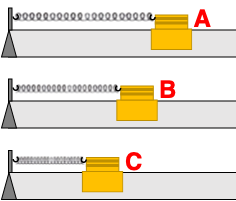 Question 9
Question 9
An air track glider is attached to a spring. It is pulled back to position A and released from rest. It vibrates back and forth between positions A and C. Position B is the equilibrium position. Assuming no damping, what changes would be observed as the mass vibrates from locations
A to B?
The
kinetic energy would …
a. increase b. decrease c. first increase and then decrease
d. first decrease and then increase e. remain unchanged
The
gravitational potential energy would …
a. increase b. decrease c. first increase and then decrease
d. first decrease and then increase e. remain unchanged
The
elastic potential energy would …
a. increase b. decrease c. first increase and then decrease
d. first decrease and then increase e. remain unchanged
The
total mechanical energy would …
a. increase b. decrease c. first increase and then decrease
d. first decrease and then increase e. remain unchanged
Question 10

An air track glider is attached to a spring. It is pulled back to position A and released from rest. It vibrates back and forth between positions A and C. Position B is the equilibrium position. Assuming no damping, what changes would be observed as the mass vibrates from locations
A to B?
The
kinetic energy would …
a. remain unchanged b. increase
c. first increase and then decrease
d. decrease e. first decrease and then increase
The
gravitational potential energy would …
a. remain unchanged b. increase
c. first increase and then decrease
d. decrease e. first decrease and then increase
The
elastic potential energy would …
a. remain unchanged b. increase
c. first increase and then decrease
d. decrease e. first decrease and then increase
The
total mechanical energy would …
a. remain unchanged b. increase
c. first increase and then decrease
d. decrease e. first decrease and then increase
 Question 11
Question 11
An air track glider is attached to a spring. It is pulled back to position A and released from rest. It vibrates back and forth between positions A and C. Position B is the equilibrium position. Assuming no damping, what changes would be observed as the mass vibrates from locations
C to B?
The
kinetic energy would …
a. increase b. decrease c. first increase and then decrease
d. first decrease and then increase e. remain unchanged
The
gravitational potential energy would …
a. increase b. decrease c. first increase and then decrease
d. first decrease and then increase e. remain unchanged
The
elastic potential energy would …
a. increase b. decrease c. first increase and then decrease
d. first decrease and then increase e. remain unchanged
The
total mechanical energy would …
a. increase b. decrease c. first increase and then decrease
d. first decrease and then increase e. remain unchanged
 Question 12
Question 12
An air track glider is attached to a spring. It is pulled back to position A and released from rest. It vibrates back and forth between positions A and C. Position B is the equilibrium position. Assuming no damping, what changes would be observed as the mass vibrates from locations
C to B?
The
kinetic energy would …
a. remain unchanged b. increase
c. first increase and then decrease
d. decrease e. first decrease and then increase
The
gravitational potential energy would …
a. remain unchanged b. increase
c. first increase and then decrease
d. decrease e. first decrease and then increase
The
elastic potential energy would …
a. remain unchanged b. increase
c. first increase and then decrease
d. decrease e. first decrease and then increase
The
total mechanical energy would …
a. remain unchanged b. increase
c. first increase and then decrease
d. decrease e. first decrease and then increase
Question Group 6
 Question 13
Question 13
An air track glider is attached to a spring. It is pulled back to position A and released from rest. It vibrates back and forth between positions A and C. Position B is the equilibrium position. Assuming no damping, what changes would be observed as the mass vibrates from locations
B to A?
The
kinetic energy would …
a. increase b. decrease c. first increase and then decrease
d. first decrease and then increase e. remain unchanged
The
gravitational potential energy would …
a. increase b. decrease c. first increase and then decrease
d. first decrease and then increase e. remain unchanged
The
elastic potential energy would …
a. increase b. decrease c. first increase and then decrease
d. first decrease and then increase e. remain unchanged
The
total mechanical energy would …
a. increase b. decrease c. first increase and then decrease
d. first decrease and then increase e. remain unchanged
 Question 14
Question 14
An air track glider is attached to a spring. It is pulled back to position A and released from rest. It vibrates back and forth between positions A and C. Position B is the equilibrium position. Assuming no damping, what changes would be observed as the mass vibrates from locations
B to A?
The
kinetic energy would …
a. remain unchanged b. increase
c. first increase and then decrease
d. decrease e. first decrease and then increase
The
gravitational potential energy would …
a. remain unchanged b. increase
c. first increase and then decrease
d. decrease e. first decrease and then increase
The
elastic potential energy would …
a. remain unchanged b. increase
c. first increase and then decrease
d. decrease e. first decrease and then increase
The
total mechanical energy would …
a. remain unchanged b. increase
c. first increase and then decrease
d. decrease e. first decrease and then increase
 Question 15
Question 15
An air track glider is attached to a spring. It is pulled back to position A and released from rest. It vibrates back and forth between positions A and C. Position B is the equilibrium position. Assuming no damping, what changes would be observed as the mass vibrates from locations
B to C?
The
kinetic energy would …
a. increase b. decrease c. first increase and then decrease
d. first decrease and then increase e. remain unchanged
The
gravitational potential energy would …
a. increase b. decrease c. first increase and then decrease
d. first decrease and then increase e. remain unchanged
The
elastic potential energy would …
a. increase b. decrease c. first increase and then decrease
d. first decrease and then increase e. remain unchanged
The
total mechanical energy would …
a. increase b. decrease c. first increase and then decrease
d. first decrease and then increase e. remain unchanged
 Question 16
Question 16
An air track glider is attached to a spring. It is pulled back to position A and released from rest. It vibrates back and forth between positions A and C. Position B is the equilibrium position. Assuming no damping, what changes would be observed as the mass vibrates from locations
B to C?
The
kinetic energy would …
a. remain unchanged b. increase
c. first increase and then decrease
d. decrease e. first decrease and then increase
The
gravitational potential energy would …
a. remain unchanged b. increase
c. first increase and then decrease
d. decrease e. first decrease and then increase
The
elastic potential energy would …
a. remain unchanged b. increase
c. first increase and then decrease
d. decrease e. first decrease and then increase
The
total mechanical energy would …
a. remain unchanged b. increase
c. first increase and then decrease
d. decrease e. first decrease and then increase
Activity 2 Energy Bar Charts
 Question Group 7
Question 17
Question Group 7
Question 17
An air track glider is attached to a spring. Positions A and B are two positions along its back-and-forth path. The energy bar chart for A is shown below. Identify the co rrect energy bar chart for position B.

 Question Group 8
Question 18
Question Group 8
Question 18
An air track glider is attached to a spring. Positions A and B are two positions along its back-and-forth path. The energy bar chart for A is shown below. Identify the correct energy bar chart for position B.

 Question Group 9
Question 19
Question Group 9
Question 19
An air track glider is attached to a spring. Positions A and B are two positions along its back-and-forth path. The energy bar chart for A is shown below. Identify the correct energy bar chart for position B.
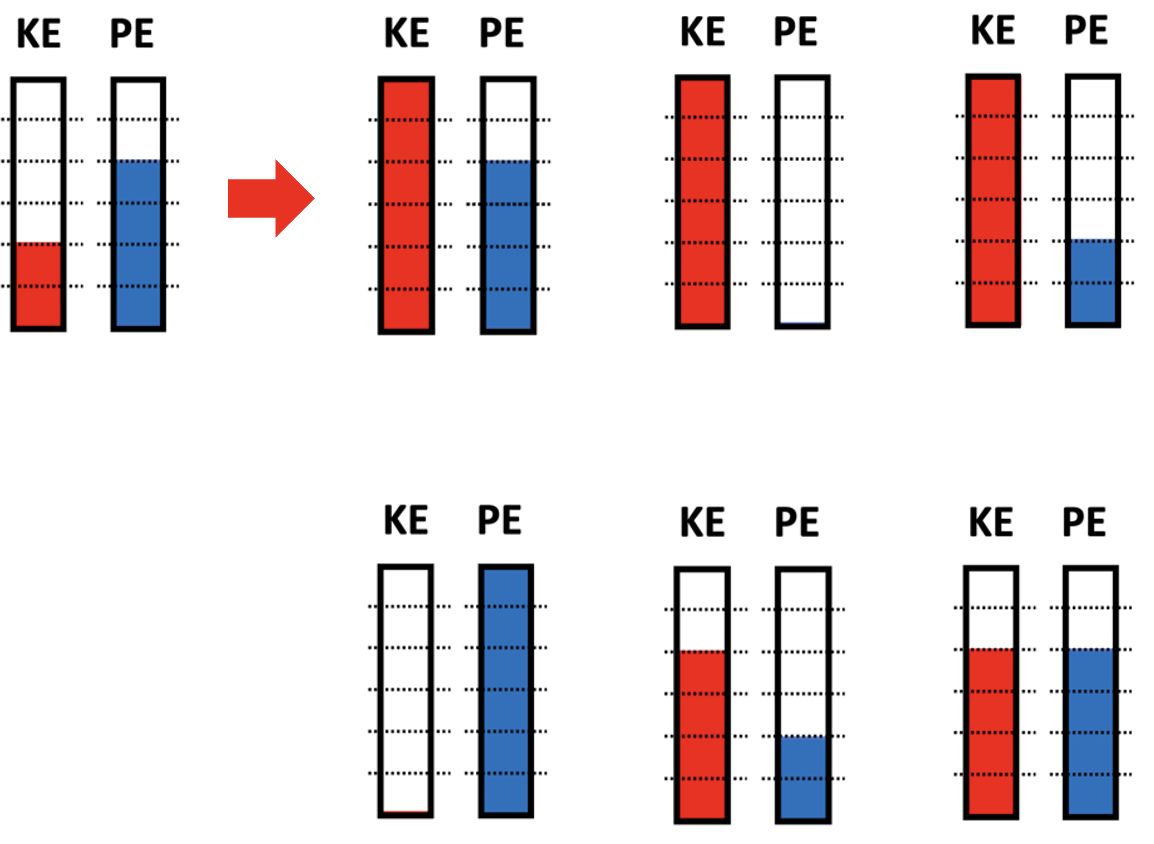 Question Group 10
Question Group 10
 Question 20
Question 20
An air track glider is attached to a spring. Positions A and B are two positions along its back-and-forth path. The energy bar chart for A is shown below. Identify the correct energy bar chart for position B.
 Question Group 11
Question Group 11
 Question 21
Question 21
An air track glider is attached to a spring. Positions A and B are two positions along its back-and-forth path. The energy bar chart for A is shown below. Identify the correct energy bar chart for position B.

 Question Group 12
Question 22
Question Group 12
Question 22
An air track glider is attached to a spring. Positions A and B are two positions along its back-and-forth path. The energy bar chart for A is shown below. Identify the correct energy bar chart for position B.
 Activity 3: Do It With Numbers (Horizontal)
Activity 3: Do It With Numbers (Horizontal)
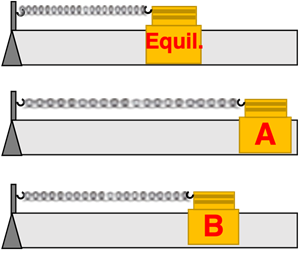 Question Group 13
Question 23
Question Group 13
Question 23
A mass is attached to a horizontal spring and vibrating back and forth. At location A, the PE is 12 J and the KE is 0 J. Determine the energy values at location B.
 Question 24
Question 24

A mass is attached to a horizontal spring and vibrating back and forth. At location A, the PE is 12 J and the KE is 0 J. Determine the energy values at location B.

 Question 25
Question 25
A mass is attached to a horizontal spring and vibrating back and forth. At location A, the PE is 12 J and the KE is 0 J. Determine the energy values at location B.

 Question 26
Question 26
A mass is attached to a horizontal spring and vibrating back and forth. At location A, the PE is 12 J and the KE is 0 J. Determine the energy values at location B.
 Question Group 14
Question Group 14
 Question 27
Question 27
A mass is attached to a horizontal spring and vibrating back and forth. At location A, the PE is 4 J and the KE is 12 J. Determine the energy values at location B.

 Question 28
Question 28
A mass is attached to a horizontal spring and vibrating back and forth. At location A, the PE is 4 J and the KE is 12 J. Determine the energy values at location B.

 Question 29
Question 29
A mass is attached to a horizontal spring and vibrating back and forth. At location A, the PE is 4 J and the KE is 12 J. Determine the energy values at location B.

 Question 30
Question 30
A mass is attached to a horizontal spring and vibrating back and forth. At location A, the PE is AAA J and the KE is BBB J. Determine the energy values at location B.
 Question Group 15
Question Group 15
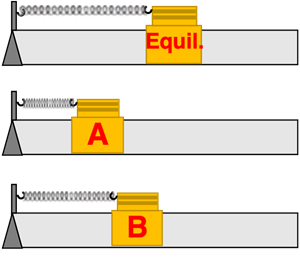 Question 31
Question 31
A mass is attached to a horizontal spring and vibrating back and forth. At location A, the PE is 10 J and the KE is 0 J. Determine the energy values at location B.
 Question 32
Question 32

A mass is attached to a horizontal spring and vibrating back and forth. At location A, the PE is 10 J and the KE is 0 J. Determine the energy values at location B.
 Question 33
Question 33

A mass is attached to a horizontal spring and vibrating back and forth. At location A, the PE is 10 J and the KE is 0 J. Determine the energy values at location B.
 Question 34
Question 34

A mass is attached to a horizontal spring and vibrating back and forth. At location A, the PE is 10 J and the KE is 0 J. Determine the energy values at location B.

 Question Group 16
Question 35
Question Group 16
Question 35
A mass is attached to a horizontal spring and vibrating back and forth. At location A, the PE is 2 J and the KE is 6 J. Determine the energy values at location B.

 Question 36
Question 36
A mass is attached to a horizontal spring and vibrating back and forth. At location A, the PE is 2 J and the KE is 6 J. Determine the energy values at location B.

 Question 37
Question 37
A mass is attached to a horizontal spring and vibrating back and forth. At location A, the PE is 2 J and the KE is 6 J. Determine the energy values at location B.

 Question 38
Question 38
A mass is attached to a horizontal spring and vibrating back and forth. At location A, the PE is 2 J and the KE is 6 J. Determine the energy values at location B.

 Question Group 17
Question 39
Question Group 17
Question 39
A mass is attached to a horizontal spring and vibrating back and forth. At location A, the PE is 4 J and the KE is 8 J. Determine the energy values at location B.

 Question 40
Question 40
A mass is attached to a horizontal spring and vibrating back and forth. At location A, the PE is 4 J and the KE is 8 J. Determine the energy values at location B.

 Question 41
Question 41
A mass is attached to a horizontal spring and vibrating back and forth. At location A, the PE is 4 J and the KE is 8 J. Determine the energy values at location B.

 Question 42
Question 42
A mass is attached to a horizontal spring and vibrating back and forth. At location A, the PE is 4 J and the KE is 8 J. Determine the energy values at location B.

 Question Group 18
Question 43
Question Group 18
Question 43
A mass is attached to a horizontal spring and vibrating back and forth. At location A, the PE is 4 J and the KE is 8 J. Determine the energy values at location B.

 Question 44
Question 44
A mass is attached to a horizontal spring and vibrating back and forth. At location A, the PE is 4 J and the KE is 8 J. Determine the energy values at location B.

 Question 45
Question 45
A mass is attached to a horizontal spring and vibrating back and forth. At location A, the PE is 4 J and the KE is 8 J. Determine the energy values at location B.

 Question 46
Question 46
A mass is attached to a horizontal spring and vibrating back and forth. At location A, the PE is 4 J and the KE is 8 J. Determine the energy values at location B.
 Activity 4 Do It With Numbers (Vertical)
Question Group 19
Activity 4 Do It With Numbers (Vertical)
Question Group 19
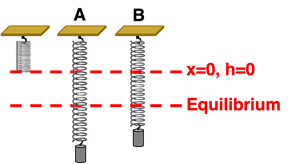 Question 47
Question 47
A mass is attached to a vertical spring and vibrating up and down. At location A, the PE
grav is -1.200 J, the PE
spring is 0.900 J and the KE is 0 J. Determine the energy values at location B.
 Question 48
Question 48

A mass is attached to a vertical spring and vibrating up and down. At location A, the PE
grav is -1.200 J, the PE
spring is 0.900 J and the KE is 0 J. Determine the energy values at location B.
 Question 49
Question 49

A mass is attached to a vertical spring and vibrating up and down. At location A, the PE
grav is -1.200 J, the PE
spring is 0.900 J and the KE is 0 J. Determine the energy values at location B.
 Question 50
Question 50

A mass is attached to a vertical spring and vibrating up and down. At location A, the PE
grav is -1.200 J, the PE
spring is 0.900 J and the KE is 0 J. Determine the energy values at location B.
 Question Group 20
Question 51
Question Group 20
Question 51
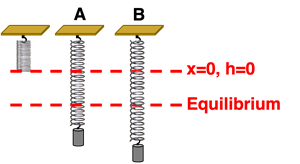
A mass is attached to a vertical spring and vibrating up and down. At location A, the PE
grav is -0.800 J, the PE
spring is 0.800 J and the KE is 0.600 J. Determine the energy values at location B.
 Question 52
Question 52

A mass is attached to a vertical spring and vibrating up and down. At location A, the PE
grav is -0.800 J, the PE
spring is 0.800 J and the KE is 0.600 J. Determine the energy values at location B.
 Question 53
Question 53

A mass is attached to a vertical spring and vibrating up and down. At location A, the PE
grav is -0.800 J, the PE
spring is 0.800 J and the KE is 0.600 J. Determine the energy values at location B.
 Question 54
Question 54

A mass is attached to a vertical spring and vibrating up and down. At location A, the PE
grav is -0.800 J, the PE
spring is 0.800 J and the KE is 0.600 J. Determine the energy values at location B.
 Question Group 21
Question 55
Question Group 21
Question 55

A mass is attached to a vertical spring and vibrating up and down. At location A, the PE
grav is -0.600 J, the PE
spring is 0.225 J and the KE is 0.075 J. Determine the energy values at location B.
 Question 56
Question 56

A mass is attached to a vertical spring and vibrating up and down. At location A, the PE
grav is -0.600 J, the PE
spring is 0.225 J and the KE is 0.075 J. Determine the energy values at location B.
 Question 57
Question 57

A mass is attached to a vertical spring and vibrating up and down. At location A, the PE
grav is -0.600 J, the PE
spring is 0.225 J and the KE is 0.075 J. Determine the energy values at location B.
 Question 58
Question 58

A mass is attached to a vertical spring and vibrating up and down. At location A, the PE
grav is -0.600 J, the PE
spring is 0.225 J and the KE is 0.075 J. Determine the energy values at location B.
 Question Group 22
Question 59
Question Group 22
Question 59

A mass is attached to a vertical spring and vibrating up and down. At location A, the PE
grav is -1.50 J, the PE
spring is 0.45 J and the KE is 0 J. Determine the energy values at location B.
 Question 60
Question 60

A mass is attached to a vertical spring and vibrating up and down. At location A, the PE
grav is -1.50 J, the PE
spring is 0.45 J and the KE is 0 J. Determine the energy values at location B.
 Question 61
Question 61

A mass is attached to a vertical spring and vibrating up and down. At location A, the PE
grav is -1.50 J, the PE
spring is 0.45 J and the KE is 0 J. Determine the energy values at location B.
 Question 62
Question 62

A mass is attached to a vertical spring and vibrating up and down. At location A, the PE
grav is -1.50 J, the PE
spring is 0.45 J and the KE is 0 J. Determine the energy values at location B.
 Question Group 23
Question 63
Question Group 23
Question 63
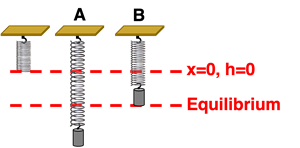
A mass is attached to a vertical spring and vibrating up and down. At location A, the PE
grav is -4.00 J, the PE
spring is 3.20 J and the KE is 0 J. Determine the energy values at location B.
 Question 64
Question 64

A mass is attached to a vertical spring and vibrating up and down. At location A, the PE
grav is -4.00 J, the PE
spring is 3.20 J and the KE is 0 J. Determine the energy values at location B.
 Question 65
Question 65

A mass is attached to a vertical spring and vibrating up and down. At location A, the PE
grav is -4.00 J, the PE
spring is 3.20 J and the KE is 0 J. Determine the energy values at location B.
 Question 66
Question 66

A mass is attached to a vertical spring and vibrating up and down. At location A, the PE
grav is -4.00 J, the PE
spring is 3.20 J and the KE is 0 J. Determine the energy values at location B.
 Question Group 24
Question 67
Question Group 24
Question 67
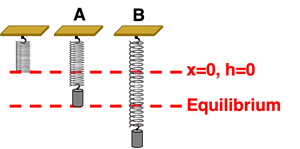
A mass is attached to a vertical spring and vibrating up and down. At location A, the PE
grav is -1.2 J, the PE
spring is 0.45 J and the KE is 0.15 J. Determine the energy values at location B.
 Question 68
Question 68

A mass is attached to a vertical spring and vibrating up and down. At location A, the PE
grav is -1.2 J, the PE
spring is 0.45 J and the KE is 0.15 J. Determine the energy values at location B.
 Question 69
Question 69

A mass is attached to a vertical spring and vibrating up and down. At location A, the PE
grav is -1.2 J, the PE
spring is 0.45 J and the KE is 0.15 J. Determine the energy values at location B.
 Question 70
Question 70

A mass is attached to a vertical spring and vibrating up and down. At location A, the PE
grav is -1.2 J, the PE
spring is 0.45 J and the KE is 0.15 J. Determine the energy values at location B.
